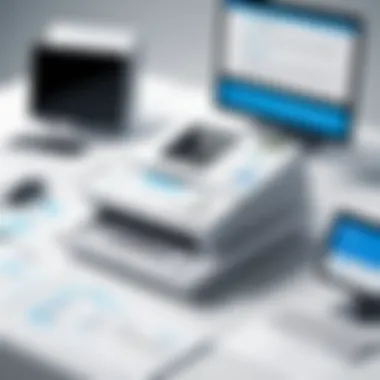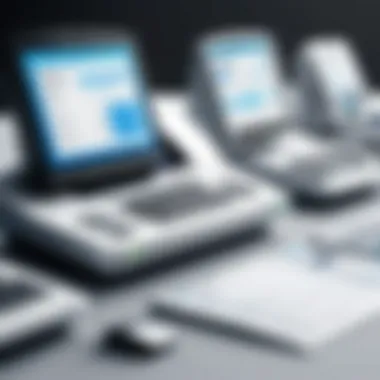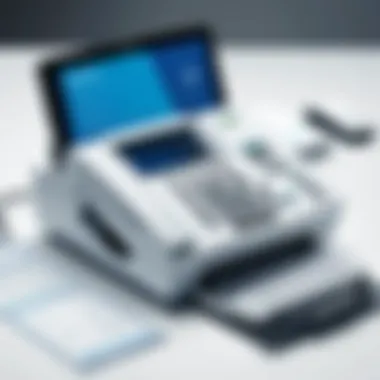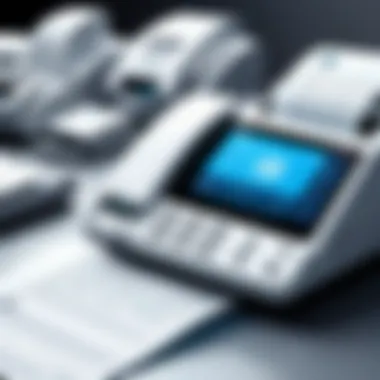An In-Depth Examination of Fax Software


Intro
The world of fax software embodies a crucial aspect of business communication and documentation. While the popularity of digital communication tools has surged, the fax remains a staple in many industries. This persistence calls for an examination of the capabilities and benefits of fax software. Understanding its features and how it integrates into existing systems is vital for decision-makers. This narrative will guide industry professionals through the essential elements of fax software, benefits, and important considerations during selection.
Overview of Core Features
Fax software comes with various functionalities that cater to the needs of modern enterprises. Key features include:
- Digital Document Transmission: Users can send documents directly from their computers without needing a physical fax machine.
- Document Storage: Most fax software offers secure storage solutions, ensuring that sent and received documents are accessible for future reference.
- Integration Capabilities: Many solutions seamlessly integrate with existing systems like Microsoft Office, Google Drive, and document management software, streamlining workflows.
- Multi-User Support: This feature allows multiple users to send and receive faxes, making it ideal for team environments.
- Tracking and Reporting: Users can monitor fax status, including delivery confirmations and error notifications.
When comparing the functionality of leading fax software options, one can discern notable differences:
- CocoFax offers robust cloud storage and an intuitive user interface.
- eFax excels in user-friendly features and mobile app support.
- MyFax has strong integration options with email services and provides comprehensive tracking.
Each serves differing needs, requiring careful evaluation based on specific business demands.
User Experience and Interface
An essential aspect of fax software lies in its user experience and interface design. A well-designed UI not only enhances usability but also minimizes the learning curve for new users.
Key considerations include:
- Intuitive Layout: A clean and organized layout allows users to effortlessly navigate through the application, facilitating the quick sending and receiving of faxes.
- Accessibility Features: It's crucial that software accommodates all potential users, including those with disabilities. Tools supporting screen readers and keyboard shortcuts are highly beneficial.
- Customer Support: The level of support offered by the provider is crucial. Effective support can improve user experience significantly and assist in troubleshooting any issues encountered.
"User-friendly design is not just about aesthetics; it is about understanding user needs and behavior to streamline tasks effectively."
Overall, the emphasis on usability in fax software is paramount, as it directly impacts employee efficiency and productivity. This consideration can be particularly significant for larger organizations with varied users.
Ending
In light of the features outlined above, fax software emerges as an indispensable tool for many organizations. As communication evolves, so too must the tools that support it. Decision-makers should weigh features, user experience, and integration capabilities when selecting software. The evolving landscape of fax technology highlights an essential reality: while digital communication methods mature, fax software continues to assert its relevance and necessity in the corporate domain, paving the way for a more efficient future in document handling.
Foreword to Fax Software
Fax software is a crucial element in the realm of document exchange. It serves as a bridge between traditional faxing methods and modern digital communication practices. The relevance of fax software lies in its ability to streamline workflows, enhance productivity, and maintain a reliable mode of transmitting important documents.
In today's fast-paced business environment, organizations are increasingly looking for efficient ways to handle communication. Fax software offers various benefits, such as reduced reliance on physical machines, lower operational costs, and improved accessibility. When examining fax software, it becomes necessary to factor in aspects like security features, integration capabilities, and user experience. This understanding is essential for stakeholders, especially in industries where regulatory compliance is paramount.
Defining Fax Software
Fax software is defined as a program that allows users to send and receive fax documents electronically. Unlike traditional fax machines, which are often limited by the physical constraints of paper and machine malfunctions, fax software eliminates these barriers. Users can send faxes through their computer, email, or mobile device, significantly increasing flexibility.
The software typically supports a variety of document types, including PDFs and images. This flexibility facilitates easier document management, as users can organize, retrieve, and transmit documents digitally without the need for constant printing.
The Evolution of Faxing Technology
The journey of fax technology has been notable. Originally, faxing involved analog signals and physical machines requiring dedicated phone lines. Over time, advancements led to the introduction of digital faxing solutions. This evolution has largely been driven by the need for faster and more efficient communication.
Initially, faxing was largely confined to in-office environments. Now, with the rise of cloud computing and mobile applications, fax software has transcended these limitations. Today, users can send and receive faxes from anywhere, through any device with internet access. This shift not only enhances convenience but also aligns with the growing trend towards remote work, making fax software a relevant and necessary tool for businesses.
Core Features of Fax Software
The core features of fax software hold significant weight in its effectiveness and utility in today's business environment. As organizations transition from traditional faxing methods to digital solutions, these features play a vital role in enhancing productivity and facilitating seamless communication. Understanding these key elements helps decision-makers to choose the right software for their needs, ensuring alignment with operational demands and strategic objectives.


User Interface and Usability
A user-friendly interface is essential for any software, and fax software is no exception. A well-designed user interface simplifies the process of sending and receiving faxes, making it accessible even for those who are not technologically savvy. Users should be able to navigate the software with ease, locating relevant functions without excessive effort.
Usability includes features like drag-and-drop support for document uploads, search functionalities to quickly access sent and received faxes, and customizability to modify the layout according to personal preferences. Software like eFax and MyFax provides intuitive dashboards that enhance user interaction. The simpler the interface, the higher the likelihood of adoption among staff, ultimately promoting productivity.
Document Management Capabilities
Document management is a critical aspect of fax software. The ability to organize, store, and retrieve documents efficiently is indispensable for any business. Fax software should offer features that allow users to easily categorize their faxes, access them through search options, and maintain a comprehensive archive.
Many modern solutions enable integration with cloud storage services like Google Drive and Dropbox, facilitating secure document storage and easy retrieval. This integration permits users to manage documents from various locations, enhancing flexibility remote work. Additionally, the capability to convert faxes into editable formats preserves data accuracy a dynamically processes ongoing business needs.
Integration with Other Software
Integration capabilities are increasingly significant as organizations utilize multiple software applications to enhance workflow. Effective fax software should seamlessly integrate with existing systems like Salesforce, Microsoft Office, or accounting software. This allows faxing to become part of a more extensive process rather than a separate function.
The integration ensures that important documents can be sent directly from other applications, streamlining operations. It eliminates the need to switch between multiple platforms, thus reducing the time spent on fax-related tasks. Ultimately, this supports efficient communication flows and operational coherence across departments.
Security Features and Compliance
Security is a paramount concern. The sensitive nature of documents being faxed demands robust security features within the software. This includes encryption of data both in transit and at rest, secure user authentication protocols, and comprehensive compliance with legal standards such as HIPAA for healthcare-related documents.
Software like RightFax implements strong security measures to mitigate risks associated with data breaches, providing users with peace of mind. Regular updates and audits must also be part of the solution to ensure ongoing compliance and protection against emerging threats.
Customization and Scalability Options
Customizability and scalability are important considerations for organizations of varying sizes and industries. Fax software should offer options for customization, allowing users to tailor settings such as templates, workflows, and automated messages. This flexibility accommodates specific business requirements and enhances user efficiency.
Scalability is equally crucial. As businesses grow, their communication needs evolve. Hence, fax software must adapt to increasing volumes of documents while ensuring performance remains unaffected. Solutions such as iFax enable users to scale their services easily, adding features and users as necessary without requiring a complete overhaul of existing systems.
Comparison of Top Fax Software Solutions
In the context of contemporary business practices, the selection of suitable fax software plays a critical role in ensuring streamlined communication and efficiency. With numerous options available in the market, it becomes imperative for organizations to engage in a thorough comparison of fax software solutions. This examination not only reveals the distinctive features and capabilities of each solution but also assists decision-makers in identifying the platform that aligns best with their operational requirements and strategic objectives.
When comparing fax software, certain elements emerge as pivotal. These include the user interface, integration capabilities, security measures, and pricing models. Each of these factors greatly influences how effectively the software meets an organization’s specific needs. For instance, user-friendliness can directly impact employee adoption rates, while robust security features are essential to safeguarding sensitive information.
Leading Software Reviews
Several notable fax software solutions dominate the market, each offering its unique set of features and capabilities. Popular contenders include:
- eFax: This platform is known for its simplicity and powerful document management tools. eFax allows users to send and receive faxes via email, making it convenient for remote work environments.
- FaxBurner: Particularly useful for small businesses, FaxBurner offers a mobile-friendly interface. Users can create temporary fax numbers, which is ideal for infrequent users.
- MyFax: This software distinguishes itself with its comprehensive support for documents in various formats. MyFax also provides international faxing capabilities.
- MetroFax: With its competitive pricing and advanced features, MetroFax is designed for businesses needing high-volume faxing without sacrificing quality.
Each of these solutions has been reviewed extensively based on user feedback, performance metrics, and feature set. Engaging with software reviews can provide vital insights into how well these solutions perform in real-world scenarios.
Pricing Models and Value for Money
Pricing structure is another crucial factor when considering fax software. Most providers offer different tiers or plans that cater to varying business needs. These can range from pay-per-fax options to subscription models that provide a set number of faxes per month. Users should analyze which model best fits their anticipated faxing volume.
- Pay-as-you-go: This model benefits organizations with sporadic fax requirements. It enables costs to remain low without a monthly commitment.
- Monthly subscriptions: These typically offer a fixed number of faxes for a flat fee. This is suitable for businesses with consistent fax demands.
- Enterprise solutions: Larger organizations may require customized plans that include bulk faxing options, administrative controls, and heightened security features.
"Understanding the pricing models is essential for budgeting effectively and ensuring that you receive maximum value for your investment in fax software."
Ultimately, organizations must not only look at the upfront costs but also consider the overall value derived from each solution, including features, reliability, and customer support.


Benefits of Using Fax Software
Fax software has increasingly become a vital tool in business communication. Its significance in today's fast-paced digital world is found in its ability to simplify and secure document transmission. Organizations across various sectors recognize the distinct benefits this technology provides, from operational efficiency to cost savings. Understanding these advantages helps decision-makers appreciate the role of fax software in modern workflows.
Efficiency Improvements in Document Transmission
One of the most notable benefits of fax software is the enhancement of efficiency in document transmission. Traditional faxing methods often involve physical paperwork, which can result in delays. With fax software, sending documents becomes swift and straightforward. Users can transmit files directly from their computers or mobile devices without needing a dedicated fax machine. This immediacy helps reduce turnaround times significantly.
Moreover, let’s not forget about tracking. Advanced fax software allows users to monitor the status of their transmissions in real-time. Knowing when a document is sent, delivered, or viewed adds a layer of transparency that is often lacking in conventional methods. Automated logs and notifications contribute to overall operational efficiency by reducing the chances of lost or unprocessed documents, ensuring that important information reaches its destination promptly.
Cost Reductions in Business Operations
Implementing fax software can lead to significant cost reductions in business operations. Traditional faxing involves costs related to paper, ink, and maintenance of fax machines. Additionally, there are often hidden costs associated with manual labor devoted to sending, receiving, and filing documents.
In contrast, fax software reduces these expenses considerably. Organizations can minimize their reliance on physical materials and the associated costs. For example, by moving to a paperless environment, firms not only save money but also contribute to environmental sustainability. Furthermore, many fax software solutions operate on subscription models, which can be more predictable and economical compared to maintaining physical faxing equipment.
Enhanced Security and Compliance
Security is a crucial aspect of any communication method, especially in industries like healthcare and finance. Fax software provides enhanced security features that are often not available in traditional faxing. Many solutions include encryption and compliance with industry standards such as HIPAA, ensuring sensitive information is protected during transmission.
Moreover, electronic faxing minimizes the risk of documents being misplaced or ending up in the wrong hands, as it eliminates the need for physical document handling. Audit trails and secure access also contribute to a higher level of accountability, which is essential for maintaining compliance with regulatory requirements.
"The integration of fax software is not merely about adopting new tools; it is about redefining security and efficiency in document handling."
In summary, the benefits of using fax software extend beyond simple document transmission. Efficiency, cost savings, and heightened security form the foundation upon which organizations can build a more responsive and responsible approach to communication. Understanding these factors allows decision-makers in various sectors to make informed choices, thereby leveraging fax software to enhance their operational capabilities.
Considerations for Selecting Fax Software
When delving into fax software, it is crucial to assess considerations that greatly impact decision-making. Choosing the right fax software can affect productivity, communication efficiency, and overall operational costs. This section outlines several key factors that decision-makers should consider when evaluating options for their organizations.
Assessing Organizational Needs
The first step in selecting fax software involves identifying the specific needs of the organization. Each business operates within its unique context, and understanding these requirements can guide the choice of software. Consider the volume of faxes sent and received regularly. High-volume environments may necessitate robust features such as batch faxing and automatic routing. Additionally, factor in the types of documents predominantly handled. Businesses dealing with sensitive health records may require software that complies with HIPAA regulations.
Furthermore, it is vital to consider user access requirements. Will multiple departments need to access the fax system? Should functionalities differ between roles? Identifying these aspects helps in pinpointing a software solution that effectively addresses your organization’s operational dynamics.
Evaluating Software Compatibility
In an era where digital transformation is paramount, ensuring that fax software is compatible with existing systems is essential. Evaluate the integration capabilities of potential software. Does it work seamlessly with other tools, such as customer relationship management (CRM) systems and document management software? Integration can greatly streamline processes, allowing for smoother workflows.
Also, consider the operating systems in use within the organization. Some fax software may only function on certain platforms, thereby limiting usability. Understanding the technological environment aids in making selections that prevent future compatibility issues, enhancing long-term system effectiveness.
Understanding User Experience and Reviews
Finally, user experience should not be overlooked. Reviews from current users can offer valuable insights into the software's functionality and user-friendliness. Pay attention to feedback regarding the ease of navigation, setup processes, and customer support. An intuitive interface can significantly reduce the training time for staff and quicken overall adoption.
Acknowledge the importance of post-implementation support. Reliable customer service is vital, especially in case of issues that may arise during operation. Consider searching on platforms such as Reddit or Facebook groups for real user discussions about specific software. These insights can provide a clearer picture of what to expect from using the software in a real-world context.
"The right choice of fax software can not only save time but also enhance operational integrity across various departments."
By carefully evaluating organizational needs, compatibility with existing systems, and user experiences, decision-makers can arrive at a well-informed choice that aligns with their requirements. Each of these steps contributes to selecting fax software that maximizes efficiency and ensures effective communication.
Security Challenges with Fax Software


In an era where data security is paramount, understanding the security challenges associated with fax software is crucial for any organization. Businesses rely on faxing for sensitive documents, making it essential to identify potential vulnerabilities and mitigate risks. As communication methods evolve, so do the threats, necessitating a proactive approach towards protecting information transmitted via fax.
Data Breaches and Risks
Fax software, while offering convenience, is not immune to data breaches. One primary concern is unsecured transmissions. If a fax is sent over an unsecured network, it might be intercepted by malicious parties looking to exploit sensitive data. Additionally, many companies use traditional fax machines that could easily allow unauthorized access.
Other risks include software vulnerabilities. Like all software, fax applications can have security flaws that hackers might exploit. This makes regular updates and security patches vital. Additionally, improper disposal of old documents can lead to unintended exposure of sensitive information.
User errors are another concern. Employees may inadvertently send faxes to the wrong recipient or fail to utilize encryption features. This highlights the need for proper training on secure faxing practices.
- Unsecured transmissions can be intercepted.
- Software vulnerabilities may expose sensitive information.
- User errors can lead to document misdelivery.
Best Practices for Secure Faxing
Implementing best practices for secure faxing is essential for minimizing risks. Organizations should consider the following measures to enhance security:
- Use Encryption: Ensure that documents sent via fax are encrypted. This helps protect data during transmission.
- Secure Access Controls: Limit access to fax machines and software to authorized personnel only. Employ strong passwords and multi-factor authentication where possible.
- Regular Software Updates: Keep all fax software up to date to patch known vulnerabilities. This reduces the risk of exploitation.
- Training: Provide employees with regular training on secure faxing practices. They should understand the importance of verifying recipient details and using encryption.
- Audit and Monitor: Regularly audit faxing processes and monitor usage. This can help identify unusual patterns that may indicate security breaches.
"Security is not a product, but a process." – Bruce Schneier
By adopting these best practices, organizations can significantly enhance their faxing security posture, protecting sensitive information from potential threats.
Future Trends in Fax Technology
The landscape of fax technology is changing rapidly. As businesses evolve, their methods of communication must adapt accordingly. Understanding future trends in fax technology is crucial for decision-makers who want to optimize efficiency and ensure security. These trends focus on how fax systems can work seamlessly with modern tools and meet the rising expectations of users.
Integration with Cloud Services
Cloud services have become integral in nearly every aspect of business operations. They offer flexibility and accessibility, allowing users to operate from anywhere. The integration of fax software with cloud services is particularly significant.
- Accessibility: Users can send and receive faxes from any device connected to the internet. This demystifies the process of faxing, which was once tied to traditional machines.
- Storage: With cloud integration, documents can be stored securely in the cloud. This reduces the need for physical storage and simplifies document management.
- Collaboration: Teams can collaborate in real-time, sharing faxes without delay and enhancing productivity.
- Cost Efficiency: By utilizing cloud services, businesses can reduce overhead costs associated with physical fax machines, maintenance, and supplies.
As industries shift towards digital transformation, it is essential for fax software solutions to harness these cloud technologies. Companies like such as eFax, Fax.Plus, and MetroFax are leading the way, offering solutions that maximize these advantages.
"Adopting cloud-based fax solutions reduces latency and improves access to critical documents, crucial for operational success."
Advancements in Mobile Fax Solutions
As mobile technology continues to develop, fax software must follow suit. Mobile faxing solutions are becoming a necessity rather than an option. Users expect to send and receive faxes directly from their smartphones or tablets.
- Convenience: Mobile capabilities mean that users can manage their faxing needs on the go. This is especially useful for professionals traveling or working remotely.
- Usability: Modern mobile applications feature user-friendly interfaces, making the faxing process intuitive. This includes easy navigation and straightforward document uploads.
- Integration with Mobile Apps: Many mobile fax applications offer integration with existing applications such as email or document management systems. This enhances workflow by streamlining processes.
Fax software providers are continuously improving their mobile offerings. Companies like iFax and MyFax exemplify how mobile advancements can enhance the user experience, ensuring that faxing remains relevant in an increasingly digital world.
In summary, the future of fax technology hinges on its ability to integrate with cloud services and mobile platforms. Decision-makers in various industries must recognize and adapt to these trends to stay competitive.
The End
The conclusion serves as a critical synthesis of the discussions presented in this article regarding fax software. It ties together insights about core features, benefits, comparisons, and considerations, providing a clear understanding of why choosing the right fax solution is essential in today's business environment.
Summary of Key Insights
Fax software is not merely a relic of the past but an evolving tool that meets modern communication needs. Key insights include:
- Efficiency: Fax software streamlines document transmission, making it faster and more reliable than traditional methods.
- Cost-effectiveness: The digital nature of fax software can lead to significant savings in operational costs.
- Security: It emphasizes the importance of securing sensitive information in compliance with legal standards.
- Versatility: Integration with other software enhances functionality and improves user experience.
In considering these points, it is clear that fax software holds substantial value for various sectors, making informed decision-making critical.
Final Thoughts on Fax Solutions
As businesses navigate the complexities of digital transformation, the role of fax software remains pertinent. Selecting the right fax solution requires careful analysis of organizational needs, software compatibility, and user experiences. With the right choice, businesses can enhance their communication framework, ensuring secure and efficient document handling.



